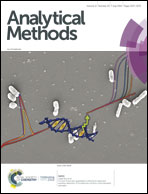Stability and biosimilarity assessment of infliximab using an orthogonal testing protocol and statistically-guided interpretation of peptide mapping†
Abstract
With the growing number of biosimilars, healthcare providers opt to switch costly originator products with biosimilars. However, extensive data are required to support biosimilarity and interchangeability. In this study, factors affecting physical and chemical stability of infliximab were assessed under various stress conditions to reveal possible degradation products. A set of orthogonal stability- and purity-indicating assays involving size exclusion, reversed phase and ion exchange chromatography in addition to quantitative TapeStation gel electrophoresis, dynamic light scattering, and functional receptor binding assay was developed and used for validation. An objective, statistically-guided interpretation of peptide mapping data using principal component analysis (PM-PCA) was performed to establish a “biosimilarity fingerprint”. SE-HPLC and dynamic light scattering were used to evaluate the formation of aggregates and/or small molecular weight fragments under non-denaturing conditions. Results were correlated with those obtained under denaturing conditions using TapeStation gel electrophoresis. Results indicated that aggregates were formed via non-reducible covalent bonds. RP-HPLC showed no oxidized forms, yet the infliximab biosimilar was relatively more hydrophilic than its innovator counterpart. Ion exchange chromatography revealed slight differences in abundance of the charge variants that were not revealed using other techniques. PM-PCA and receptor binding assay showed differences, yet they were statistically non-significant (P 0.05). Results confirmed similarity in the primary structure, higher order structure and receptor-binding pattern. In-depth investigations of the critical quality attributes of infliximab along with setting up the similarity and range were required. These helped with assessment of the impact of such slight differences on the biosimilarity and interchangeability of the studied product. The developed PM-PCA along with the orthogonal assays helped locate variability that could potentially hinder both biosimilarity and interchangeability of other complex biopharmaceuticals.



 Please wait while we load your content...
Please wait while we load your content...